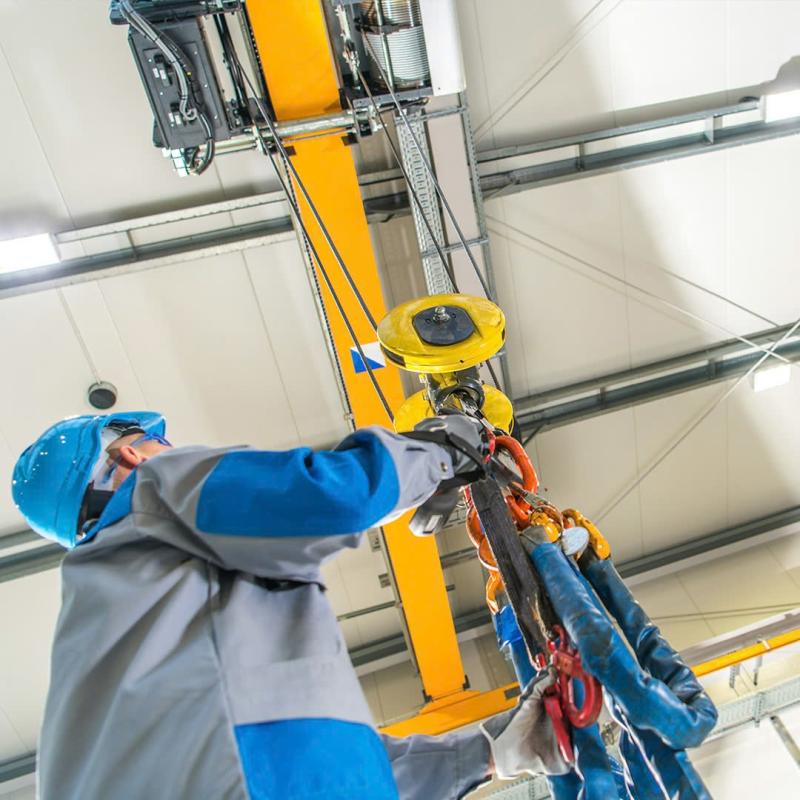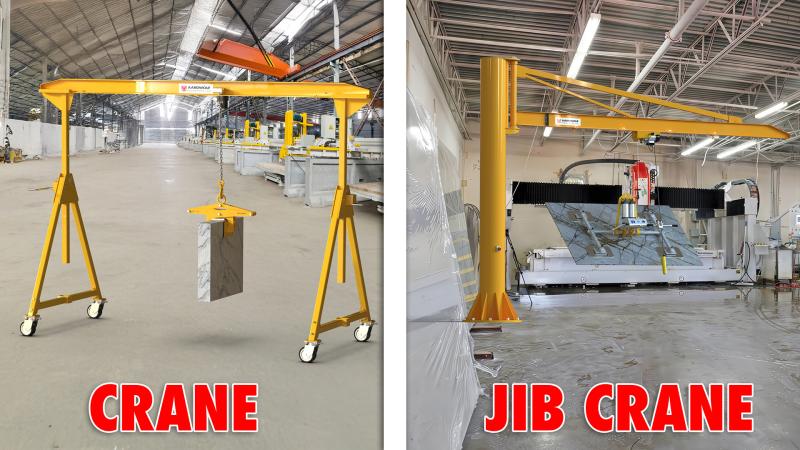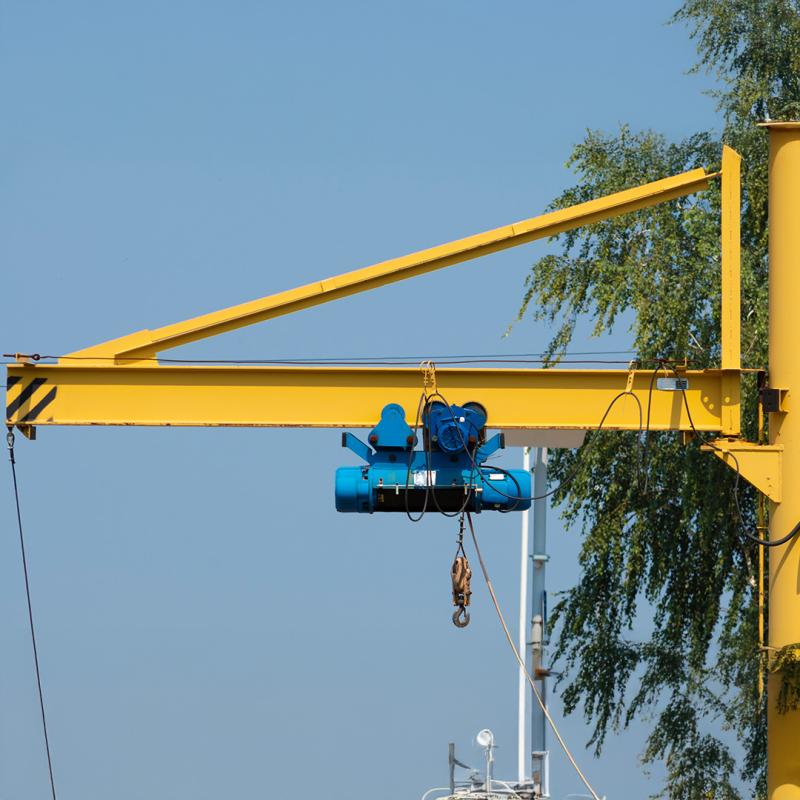



Whether in factories, warehouses, or maintenance shops, jib cranes are essential for localized, repetitive lifting tasks. But how does a jib crane actually work?
This comprehensive guide will explore the working principles behind various types of jib cranes—including freestanding jib cranes, wall mounted jib cranes, ceiling mounted jib cranes, articulating jib cranes, and pillar jib cranes—and explain their functionality, installation, and role in improving workplace efficiency.
A jib crane is a type of crane where a horizontal arm (called the jib or boom) supports a movable hoist. The hoist moves along the jib, allowing the operator to lift, lower, and move loads within a semi-circular or full circular area, depending on the type.
These cranes are ideal for workstations, assembly lines, loading docks, and other environments that require fast, localized lifting without the footprint of overhead bridge systems.
For side-by-side comparisons of cranes, read How to compare Jib Cranes.
Understanding how jib cranes work starts with knowing the main parts:
Jib Arm (Boom): The horizontal beam that carries the load.
Hoist and Trolley: Moves along the jib arm; lifts and lowers the load.
Mounting Structure: Can be floor-based, wall-mounted, or ceiling-mounted.
Rotation Mechanism: Allows the arm to swing within a defined arc (180°–360°).
Base/Foundation: Provides support and stability in freestanding models.
At its core, the functionality of a jib crane is based on:
Radial Movement: The jib arm rotates around a pivot point, allowing the hoist to cover a circular or semi-circular work area.
Linear Travel: The trolley carrying the hoist moves horizontally along the jib beam.
Vertical Lift: The hoist itself lifts and lowers loads using chain or wire rope mechanisms.
Combined, these three motions—rotation, travel, and lift—allow the crane to efficiently move loads from point A to B within a designated radius.
For deeper insight into setup and safety, see The Jib Cranes Installation.

A freestanding jib crane is anchored directly to a concrete foundation. It rotates 360 degrees and supports high-capacity loads, making it ideal for outdoor applications or open workspaces.
Functionality:
Full-circle rotation via a bearing at the base
Heavy loads supported by reinforced mast
Hoist movement via push trolley or motorized system
Applications:
Shipping yards
Industrial plants
Outdoor loading zones
A wall mounted jib crane is affixed to a load-bearing wall or column, typically offering 180°–200° of coverage.
Functionality:
Arm swings outward from the wall
Trolley moves laterally across the jib
Often used for supporting manufacturing cells
Applications:
Mechanical workshops
Assembly lines
Fabrication bays
See real-world examples in Wall-mounted Jib Cranes Installation.
Ceiling-mounted jib cranes are suspended from building beams or trusses, freeing up floor space and improving layout efficiency.
Functionality:
Rotation mechanism is fixed to the ceiling
Hoist and trolley glide over the horizontal arm
Offers seamless movement over workstations
Applications:
Lean manufacturing
Cleanrooms
Electronics and medical assembly
An articulating jib crane includes two pivoting arms, offering unmatched flexibility. These cranes are designed to navigate around obstacles and into hard-to-reach places.
Functionality:
Two rotational axes (at the base and midpoint)
Independent motion of each arm segment
Ideal for confined or obstacle-rich areas
Applications:
Precision component assembly
CNC machine loading
Automotive maintenance
Learn more at Types of Jib Cranes.
Pillar jib cranes are similar to freestanding types but may be bolted to an existing floor without the need for deep foundation work.
Functionality:
Partial to full rotation
Compact base for use near machinery
Supports moderate-capacity lifting
Applications:
Maintenance shops
Modular production cells
Medium-duty lifting tasks


Jib cranes are popular not just for their mechanical functionality but for their impact on productivity:
Reduced downtime: Workers can lift and reposition loads quickly.
Enhanced ergonomics: Cuts down on manual lifting injuries.
Optimized space usage: Wall- and ceiling-mounted cranes save valuable floor area.
Flexible deployment: Units can be installed in phases across growing facilities.
Discover ways to improve efficiency with a Jib Crane in different work environments.
When selecting a jib crane, consider the following:
| Factor | Why It Matters |
|---|---|
| Load Capacity | Must support your heaviest lifts without strain |
| Rotation Range | Full 360° for large areas; 180° for wall-mounted setups |
| Mounting Type | Depends on building infrastructure and space availability |
| Hoist Type | Manual chain, electric chain, or wire rope hoist |
| Obstacle Navigation | Articulating arms offer the best flexibility |
Need to compare setups? Visit How to compare Jib Cranes.
The future of jib cranes includes smarter, safer, and more adaptable designs:
IoT-enabled sensors for maintenance alerts and performance tracking
Programmable lifting sequences for repetitive tasks
Remote control operation for hazardous environments
Hybrid systems combining jib cranes with vacuum lifters or robotic arms
Explore The Future Trends of Jib Cranes to stay informed about what’s ahead in lifting technology.
Understanding how a jib crane works helps you appreciate its value in any facility. Whether it's a freestanding jib crane for outdoor lifting or an articulating jib crane for intricate maneuvering, each type is engineered to solve specific lifting challenges.
By knowing the mechanics, structure, and application of these systems, you can improve safety, reduce downtime, and increase productivity in your operations.
To get started with planning or upgrading your crane system, revisit The Jib Cranes Installation or explore innovative models like Types of Jib Cranes.
References
1. How to operate a Jib Cranes safely
3. Over brace jib crane wall mounted
5. Is a Jib Crane a Gantry Crane
6. Articulated Jib Crane Wall Mounted
8. Manual Counterbalance Crane
10. Over Braced Jib Crane Column Mounted
Sign up to receive the latest info on new Aardwolf products, special offers and more.
By signing up you agree to receive emails from Aardwolf with news, special offers, promotions and other information. You can unsubscribe at any time.